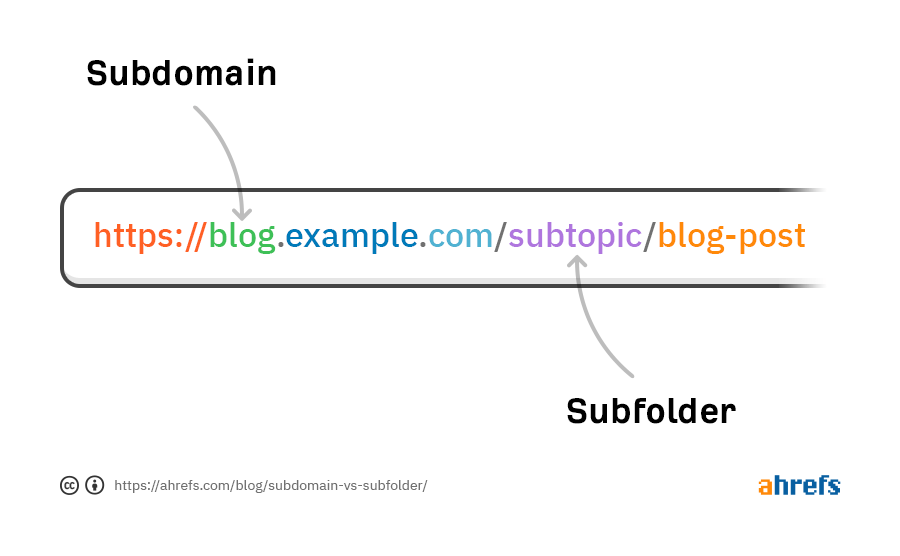Subdomain vs Subdirectory: Differences & Which is Better For SEO
Jan 28, 2022.png)
Table of Contents
Differences Between Subdomains and Subdirectories
What Is a Subdomain?
What Is a Subdirectory?
Are Subdomains Bad for SEO?
Subdomain vs Subdirectory: Which Is Better for SEO?
When Should You Use a Subdomain?
When Should You Use a Subdirectory?
Advantages Of a Subdomain
Advantages Of a Subdirectory
Subdomain vs Subdirectory: Which Is Right for You?
Subdomain vs. subdirectory is one of the SEO debates that has been continuing for years.
Some digital marketers consider subdirectories best for SEO, while others are of the opinion that subdomains can also do well for SEO.
If you are confused about which URL path to choose for your website, this article has all the answers.
Before we declare the winner of the subdomain vs. subdirectory debate, it's better to understand the differences between the two.
Let's begin.
Differences Between Subdomains and Subdirectories
The most significant difference between a subdomain and a subdirectory is that - subdomains are treated as separate entities by Google and other search engines, while subdirectories are considered a part of the main domain.
What does this mean?
In simpler terms, URLs that are considered a part of the main domain are easy to rank. In contrast, URLs that are regarded as separate entities are hard to rank until the subdomain acquires a considerable reputation.
Another crucial difference between a subdomain and a subdirectory is that a subdomain is located on the left side of the root domain, while the subdirectory is present on the right side of the main domain.

Image Source: Ahrefs
To make the concept more clear, I will break this up into different subtopics and add relevant examples of subdomains and subdirectories.
What Is a Subdomain?
A subdomain is an additional section of your main domain representing a particular department, service, or function related to the organization.
The whole idea of a subdomain is to have a section in your website that you want to function separately and not associate with the functions of the main domain.
The subdomain is present on the left side of the root domain. Here is an example of a subdomain:
mysubdomain.example.com
Where mysubdomain is the name of the subdomain.
en.wikipedia.org is an example of a subdomain that hosts articles in the English language.

Similarly, other subdomains of Wikipedia such as es.wikipedia.org (for Spanish), ru.wikipedia.org (for Russian), de.wikipedia.org (for German), etc., all host articles in different languages.
So, what are the subdomains doing?
They are functioning as separate entities solving a particular purpose. In this case, offering content to the users in their regional language is the primary purpose of the subdomains.
Here is an example of a subdomain from the popular gaming site Minecraft created as a help community for Minecraft gamers.

Some other popular examples of subdomains and their functions are provided in the below table:
| Domain | Domain Purpose | Subdomain | Subdomain Purpose |
| Hubspot.com | To sell a software | community.hubspot.com | The subdomain serves as the hub for all conversations around HubSpot. Users can ask questions, find answers or share their opinions about the platform. |
| Google.com | To serve as a search engine helping users find information across the web. | developers.google.com | A specific section of Google that educates users to improve the SEO of their website. It has tons of information, tools, and resources to help a website discoverable to Google search. |
|
Google.com |
To serve as a search engine helping users find information across the web. | play.google.com | Another subdomain of Google that helps people find and enjoy their favorite apps, games, movies, and more. |
| Facebook.com | To allow people to create an account and connect with family, friends, and other people they know. | business.facebook.com | Helps users manage ads on the Facebook platform. This section is only for advertisers on Facebook who manage multiple pages and ad accounts. |
In each of the above examples of subdomains, the common factor is, every subdomain is created for a particular purpose.
The primary purpose of the root domain is different from the purpose of the subdomain.
What Is a Subdirectory?
A subdirectory is a section of the root domain used to organize content on the website.
Subdirectories are also referred to as subfolders.
The content in the subdirectory shares the same purpose as the content offered in the main domain.
The subdirectory's name is written on the right side of the root domain.
An example of a subdirectory is:
domain.com/category/
Where category is the name of the subdirectory.
For example, an SEO agency can have different subdirectories under its domain, each reflecting a particular category of service they provide, such as:
exampleseoagency.com/seo-services
exampleseoagency.com/link-building-services
exampleseoagency.com/speed-optimization-services
Or, an eCommerce store can have several subdirectories, each catering to a specific audience segment but servicing the same purpose. Examples are:
Exampleecommercestore.com/men/
Exampleecommercestore.com/women/
Exampleecommercestore.com/children/
Moreover, the subcategories can have further subdirectories and pages belonging to the parent subdirectory:
Exampleecommercestore.com/men/t-shirts/black
Exampleecommercestore.com/women/t-shirts/black
Exampleecommercestore.com/children/t-shirts/black
Every subdirectory and subpages share the same purpose.
In the case of an eCommerce store, the objective is to sell clothes, while in the case of an SEO agency, the aim is to sell different SEO services.
Here is the subdirectory structure followed by the popular clothing brand, H&M

I am sure you understand the differences between a subdomain and a subdirectory. The difference lies in the purpose.
In the case of a subdomain, the goal is always different, while in the case of a subdirectory, the aim is the same.
Are Subdomains Bad for SEO?
There is no straightforward answer to this question. It depends on your purpose.
If you already have a reputable domain and want to add a blog on your website where you wish to share the latest news and updates related to your company, creating a subdirectory would be better for SEO.
Subdirectories will acquire all the SEO value of the main domain.
Therefore, the pages that you will add to your blog will quickly get indexed and start ranking on Google (depending on the other Google ranking factors).
The new pages located under the subdirectory will get link juice from the authority of the root domain, and as a result, their page authority and page rank will increase.
However, if you create a subdomain for your blog, it will be treated as a separate entity by the search engines meaning the root domain authority and the page rank will not be passed to the subdomain.

You can think of a subdomain as a separate entity within your main website.
You will have to build links and improve the subdomain page rank and authority to rank on Google and other search engines.
But, if you want a section in your website that serves an entirely different purpose, you should always go with a subdomain and not a subdirectory.
On the contrary, if you need a section in your root domain that shares a similar goal, then you should choose a subdirectory and not a subdomain.
If you ask me personally, in 90% of the cases, I prefer working with a subdirectory and not a subdomain. Since most websites often have the same purpose, going with a subdirectory definitely helps with SEO.
Subdomain vs Subdirectory: Which Is Better for SEO?
Subdirectories are better for SEO because they acquire all the link juice from the root domain, which is crucial for higher organic rankings.
Understand it this way, when you go with a subdomain, it divides your main site authority across several subdomains.
But, when you opt for a subdirectory, your site authority gets stronger because all the links to your subdirectory and pages within the subdirectory contribute to strengthening the main domain.

You should always consider your organizational needs, your marketing budget, and your website platform before you decide to go with a subfolder or a subdomain.
Both subdomains and subdirectories can give you good SEO results, provided you get the execution right and you have the budget to do so.
When Should You Use a Subdomain?
Here are some of the reasons when you might prefer to use a subdomain:
- When you want to divide your site into several different sections, each of them serving a unique purpose that does not match the primary goal of the root domain.
- When the language of your subdomain is different from the language of your root domain like when you want to serve language-specific content to your international audience.
- When you need separate software and servers to run the sections of your website divided via subdomains.
- When you are looking to target a specific market segment that is different from the main website.
When Should You Use a Subdirectory?
Here are some of the reasons when you might prefer to use a subdirectory:
- When the content of your subdirectory is relevant to the main domain, and it is in the same language as the root domain.
- When the purpose of the subfolder and the root domain is the same.
- When you are looking to target the exact audience segment as your main website.
- When you use the same servers and web resources to run your website.
Advantages Of a Subdomain
Here are the top advantages of a subdomain:
- Subdomains are treated as separate entities by the search engines. Therefore, each one of your subdomains can rank separately in the organic search engine result pages. This is particularly useful for sites with several subdomains because it helps defeat their competitors and rank more than one subdomain on the first page of the search.
- Search engines will always index your subdomain, but they might not index some of the deep pages in your subdirectory, especially if the content is too similar. Therefore subdomains will always get indexed while deep subdirectory pages might need backlinks, internal links, and valid sitemaps to get them indexed.
- You can create as many subdomains as needed without making any changes to the main website.
- Subdomains are useful for establishing topical relevance. For instance, you can club all the similar pages related to a particular topic in a subdomain mainly if it serves an entirely different purpose than the main domain.
- Businesses that serve an international audience and serve content in a different language benefit from a subdomain. Search engines can easily index the contents in the new language and rank them separately. This won't affect the rankings of your main website.
Advantages Of a Subdirectory
Here are the top advantages of the subdirectory:
- Subdirectories are easier to optimize, and the link juice from the root domain passes quickly to the subdirectories and their pages.
- For an established website, creating subdirectories and adding pages to them can get faster rankings.
- Subdirectories are easier to track because you do not need to add separate GA tracking codes for every subdirectory. The main site tracking code can easily track all the actions happening in your subfolders.
- Whenever you update any pages of your subdirectory, the freshness ranking signal comes into play. Google and other search engines consider content freshness as one of the important ranking factors to determine the quality of a website. Therefore, having subdirectories and adding fresh content is a great way to keep your entire domain updated, leading to improved rankings.
Subdomain vs Subdirectory: Which Is Right for You?
The debate over subdomain vs. subdirectory can go on and on.
There are cases when businesses find subdomains to be better than subdirectories. And, there are instances when subdirectories are preferred over subdomains.
If you only consider SEO, then subdirectories have a certain edge over subdomains. Subdirectories are good for SEO as they keep your main domain stronger.
However, you should not ignore the purpose of your website and the reasons why you might prefer to have a subdomain and not a subdirectory.
Obviously, if you keep the URL structures neat and promote the different categories and subdomains on your website uniformly, you still get the same SEO advantage with subdomains as you get with subdirectories.


